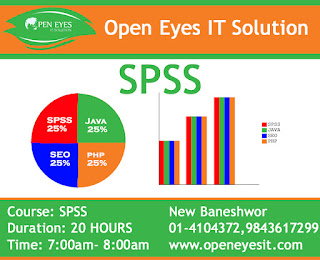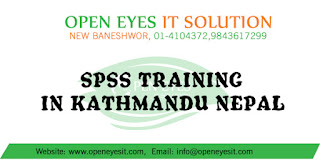 |
| SPSS Training in Kathmandu Nepal |
We start with an overview of both SPSS and also the data analysis process. We discuss the differences between surveys and experiments and also have a look at how you navigate round SPSS. We look as the difference window types that you will work with and also the different file types that SPSS uses.
The key topics trained are:
The Data Analysis Process
Surveys vs Experiments
SPSS Window Types: Data, Output, Syntax
SPSS File Types: Data, Output
Setting up your test and data correctly are key in statistical analysis. This section focuses on ensuring that you are setting up your test correcting. From there we look at labelling data and variables in SPSS. Finally we have a quick look at how you can import your data from Excel, as that is usually where the raw data is held.
 |
| SPSS Training in Kathmandu Nepal |
The key topics trained include:
The “case” concept
Choosing the right Measure
Creating Variables and choosing the right type
Variable and Value Labels
Calculating new variables
Variable Recode
Importing data from other programs (i.e. Excel)
Once you have your data set up and imported into SPSS the next step is to understand the types of tests that SPSS can carry out and the types of output that it can produce. We look at simple outputs in this section like frequency tables, charge and computing simple statistics like mean and standard deviation.
 |
| SPSS Training in Kathmandu Nepal |
The key concepts trained in this section are:
Frequency Tables
Descriptive Statistics
Crosstabulations
Charts: Frequency, Cluster, Stacked, Value Bar Charts
Simple Statistics on Groups: Computing Mean, Standard Deviation
SPSS is very good for communicating the results of the tests that you have been running. It allows you to customise your charts and tables so that you can present them clearly. It also allows you to output your results to other software applications. We look at all of these possibilities during this section of the course.
 |
| SPSS Training in Kathmandu Nepal |
The key concepts trained include:
Modifying Output Tables and Charts
Using Chart Templates
Using Table “Looks”
Including output in other applications (i.e. Word)
Managing your data is a very large subject. Having previously look at how to set up your data correctly we return to the subject to focus on data management. We look at how to work with the types of data that you may have (including missing values and dates and time) and also at selecting which data to use and aggregating / disaggregating data.
 |
| SPSS Training in Kathmandu Nepal |
The key topics trained include:
Getting data from other sources
Dealing with missing values
Selecting Cases
Using Sets
The “Visual Bander”
Splitting files
Aggregated files
Dealing with multiple response questions
Data restructuring
Working with dates, times and durations
Merging files
This section covers the basics of statistics. Before doing a test it is critical that you understand what type of data you have. This determines the types of statistical test that will be appropriate to use, and so the types of relationships between your data that you will be able to test for. We also have a look at some very widely used statistical tests.
 |
| SPSS Training in Kathmandu Nepal |
The key topics trained include:
Introduction to statistical analysis
Choosing the right Analysis
Describing categorical data
Exploratory data analysis: scale data
Probability and inferential statistics
Comparing categorical variables
Mean differences between group: T-Tests
Bivariate plots and correlations: scale variables
A look into many of the Statistical tests
Introduction to regression
Data checking
Introduction to multiple regression
No comments:
Post a Comment